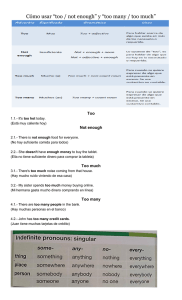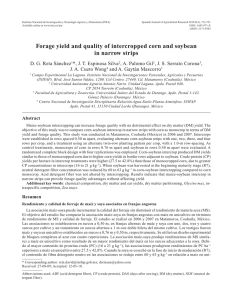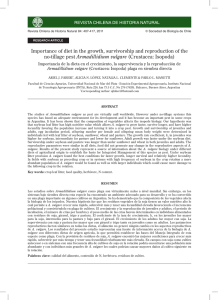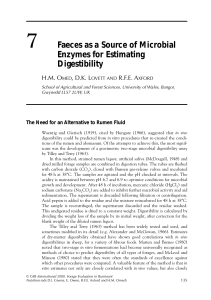Soybean as supplement of growing cattle on tropical pasture. Effects
Anuncio
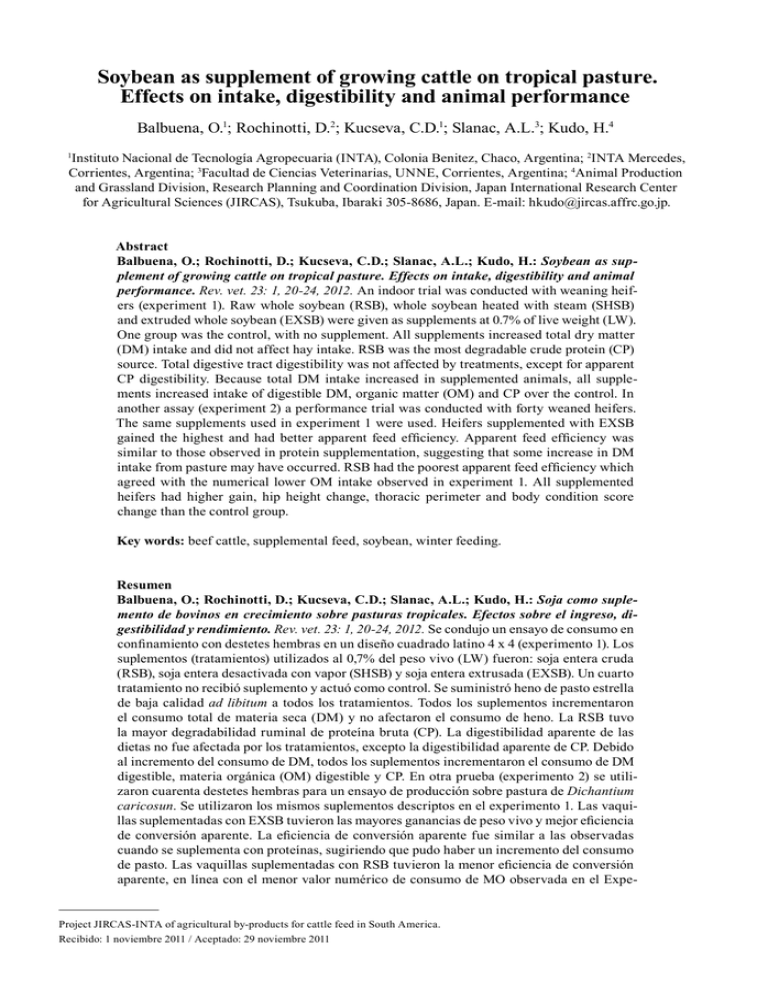
Soybean as supplement of growing cattle on tropical pasture. Effects on intake, digestibility and animal performance Balbuena, O.1; Rochinotti, D.2; Kucseva, C.D.1; Slanac, A.L.3; Kudo, H.4 Instituto Nacional de Tecnología Agropecuaria (INTA), Colonia Benitez, Chaco, Argentina; 2INTA Mercedes, Corrientes, Argentina; 3Facultad de Ciencias Veterinarias, UNNE, Corrientes, Argentina; 4Animal Production and Grassland Division, Research Planning and Coordination Division, Japan International Research Center for Agricultural Sciences (JIRCAS), Tsukuba, Ibaraki 305-8686, Japan. E-mail: [email protected]. 1 Abstract Balbuena, O.; Rochinotti, D.; Kucseva, C.D.; Slanac, A.L.; Kudo, H.: Soybean as supplement of growing cattle on tropical pasture. Effects on intake, digestibility and animal performance. Rev. vet. 23: 1, 20-24, 2012. An indoor trial was conducted with weaning heifers (experiment 1). Raw whole soybean (RSB), whole soybean heated with steam (SHSB) and extruded whole soybean (EXSB) were given as supplements at 0.7% of live weight (LW). One group was the control, with no supplement. All supplements increased total dry matter (DM) intake and did not affect hay intake. RSB was the most degradable crude protein (CP) source. Total digestive tract digestibility was not affected by treatments, except for apparent CP digestibility. Because total DM intake increased in supplemented animals, all supplements increased intake of digestible DM, organic matter (OM) and CP over the control. In another assay (experiment 2) a performance trial was conducted with forty weaned heifers. The same supplements used in experiment 1 were used. Heifers supplemented with EXSB gained the highest and had better apparent feed efficiency. Apparent feed efficiency was similar to those observed in protein supplementation, suggesting that some increase in DM intake from pasture may have occurred. RSB had the poorest apparent feed efficiency which agreed with the numerical lower OM intake observed in experiment 1. All supplemented heifers had higher gain, hip height change, thoracic perimeter and body condition score change than the control group. Key words: beef cattle, supplemental feed, soybean, winter feeding. Resumen Balbuena, O.; Rochinotti, D.; Kucseva, C.D.; Slanac, A.L.; Kudo, H.: Soja como suplemento de bovinos en crecimiento sobre pasturas tropicales. Efectos sobre el ingreso, digestibilidad y rendimiento. Rev. vet. 23: 1, 20-24, 2012. Se condujo un ensayo de consumo en confinamiento con destetes hembras en un diseño cuadrado latino 4 x 4 (experimento 1). Los suplementos (tratamientos) utilizados al 0,7% del peso vivo (LW) fueron: soja entera cruda (RSB), soja entera desactivada con vapor (SHSB) y soja entera extrusada (EXSB). Un cuarto tratamiento no recibió suplemento y actuó como control. Se suministró heno de pasto estrella de baja calidad ad libitum a todos los tratamientos. Todos los suplementos incrementaron el consumo total de materia seca (DM) y no afectaron el consumo de heno. La RSB tuvo la mayor degradabilidad ruminal de proteína bruta (CP). La digestibilidad aparente de las dietas no fue afectada por los tratamientos, excepto la digestibilidad aparente de CP. Debido al incremento del consumo de DM, todos los suplementos incrementaron el consumo de DM digestible, materia orgánica (OM) digestible y CP. En otra prueba (experimento 2) se utilizaron cuarenta destetes hembras para un ensayo de producción sobre pastura de Dichantium caricosun. Se utilizaron los mismos suplementos descriptos en el experimento 1. Las vaquillas suplementadas con EXSB tuvieron las mayores ganancias de peso vivo y mejor eficiencia de conversión aparente. La eficiencia de conversión aparente fue similar a las observadas cuando se suplementa con proteínas, sugiriendo que pudo haber un incremento del consumo de pasto. Las vaquillas suplementadas con RSB tuvieron la menor eficiencia de conversión aparente, en línea con el menor valor numérico de consumo de MO observada en el ExpeProject JIRCAS-INTA of agricultural by-products for cattle feed in South America. Recibido: 1 noviembre 2011 / Aceptado: 29 noviembre 2011 Balbuena O. et al.: Suplementación del ganado con soja. Rev. vet. 23: 1, 20-24, 2012 21 rimento 1. Las vaquillas suplementadas tuvieron mayores ganancias de peso, incremento de altura a la grupa, del perímetro toráxico y de la condición corporal que las vaquillas del tratamiento testigo sin suplementación. Palabras clave: bovinos para carne, suplementación dietaria, soja, alimentación invernal. INTRODUCTION Soybean production has increased in Argentina in recent years. Production grew from 11.7 Mt in the season 1995/96 to 35.5 Mt in the season 2003/04. Grain crushing reached 21.5 Mt and whole grain (WSB) export reached 8.5 Mt. The industry exportable coefficient is 97% for soybean meal (SBM) with 16.8 Mt 9 . That leaves ten times more WSB than SBM available for domestic consumption. About 25% of the soybean is produced far from oil factories and docks. Transportation costs favour the use of WSB as animal feed near the area where it is produced. The cost of CP is about 20 to 25% less in WSB than in SBM. Tropical pastures are fast maturing with low CP, low digestibility and low voluntary intake, especially during winter. Main constraints to beef production in Northern Argentina are low average daily gain (ADG) and low calving rates. To ensure that heifers are bred at two-years old, a supplementation program is often needed during the first winter after weaning. Excess pasture produced by the end of summer and early fall is consumed during winter as standing hay. A protein or protein plus energy supplement is needed to improve forage utilization 1, 3 . The use of SBM in dairy cattle 5 and soy by-products has been reviewed 11 . For cattle, the use of soybean hulls as an energy source has been emphasised 11 . This study explores the response to different processing of WSB on intake, digestibility and heifers performance during winter. MATERIAL AND METHODS Experiment 1. Our group is been using an experimental model were the low quality tropical grass forage available during winter under grazing conditions is simulated with the ad libitum feeding of late cutting of Stargrass hay. The weaning cattle used were similar in breed and age as those under grazing conditions. This experimental model was useful to estimate intake of hay and supplements, digesta kinetics and digestibility of total diet 1-3 . It is well known that those variables are difficult to measure under grazing conditions. Furthermore, the data provides by this experimental model helped to explain results of animal performance under grazing conditions during winter. An indoor trial was initiated in September 2003 with weaning heifers. Zebu crossbreed of eight month of age and 180 kg live weight were used. The objective was to evaluate the effect of different soybean process- ing on hay intake and total diet digestibility. And experimental 4 x 4 latin square design was used. Periods lasted 21 days and measurements were taken during the last 7 days. Low quality Stargrass hay (3.9% CP) was fed ad libitum plus a mineral supplement to all treatments. Hay was chopped to approximately 6 cm and fed ad libitum twice a day (07:30 and 19:30 h), as the base diet. Supplements were fed in restricted amount at 7:00 am, after collecting hay orts and prior to offer of new hay. Supplements were RWB, SHSB (110°C for 30 min) and EXSB, given at 0.7% of LW. The control treatment received hay alone. Supplement composition is presented in Table 1. Table 1. Composition of soybean utilized (% dry matter). fraction crude protein NDF ADF crude fiber ether extract crude ash raw soybean steam heated soybean extruded soybean 40 26 23 22 20 7 41 27 23 22 20 8 40 22 19 16 19 6 NDF: neutral detergent fiber, ADF: acid detergent fiber. Feed intake was measured during the last week of each period, assuring a 15% hay refusal. Procedures for determining voluntary intake and digestibility in sheep 8 , were followed with pertinent adaptations. Spot fecal samples were taken from the rectum every 4 h during 3 days. Hay and supplement offered, hay refusal and fecal samples were dried at 60ºC and ground through a Willey mill. Grab samples of hay were obtained, placed in air-tight plastic bags and sealed. Daily samples from a given heifer in each collection period were placed in the same bag. The total weight of the sampled hay was recorded prior to grinding. During the collection period, orts were collected prior to the morning feeding. Feeders were swept and orts collected, and transferred to woven plastic bags. Weight of orts was recorded prior to grinding. The week following the collection period, composite hay samples were dried and ground in a hammer mill, then ground in a Wiley mill to pass 4-mm and 1-mm screens and stored in plastic bags until analyzed. Orts from each heifer were air dried before grinding, and stored as described for samples of hay. Analysis of DM for intake calculation was performed the same day that the hay or orts were ground. Analytical DM 22 Balbuena O. et al.: Suplementación del ganado con soja. Rev. vet. 23: 1, 20-24, 2012 Table 2. Hay, supplement and total dry matter intake. Kg 0.7% of initial LW. Pasture was Dichantium caricosun stockpiled to assure that supplement pasture availability was not limiting for item control SE p SHSB RSB EXSB voluntary intake. The winter was dry, mean body weight, kg 190 190 184 190 3.961 0.724 with 40% of the average rainfall for that time of the year. Stocking rate was 1.5 intake, kg /day heifer/ha and average DM offered was hay 3.57 3.43 3.45 3.38 0.12 0.741 2.1, 1.6 and 1.2 tons of DM/heifer in July, supplement 1.29 1.35 1.28 0 0.02 August and October, respectively. This total 4.86a 4.78a 4.73a 3.38b 0.11 0.0002 total DM offered would suggest that intake, % body weight DM availability was not limiting for ad hay 1.88 1.78 1.87 1.78 0.053 0.448 libitum intake. There were four adjacent supplement 0.68 0.71 0.69 0 0.011 paddocks of pastures. a a a b total 2.56 2.49 2.56 1.78 0.050 0.0001 Every week, heifers of each treatment SHSB: whole soybean heated with steam, RSB: raw whole soybean, EXSB: were rotated clockwise to minimize the extruded whole soybean, SE: standard error, p: significance. ab means in a possible differences among paddocks. As row with different letters differ (p < 0.05). result of that, each of the four treatment remained at each paddock between samTable 3. Total tract diet digestibility using acid insoluble ash as inpling and weighing dates. At the beginternal marker (%). ning and at the end of the experiment, full and shrunk weight, hip height, thoracic supplement digestibility, % control SE p perimeter and body condition score (1 to SHSB RSB EXSB 9) were recorded. Every 28 d, full weight dry matter 57.7 54.8 60.2 58.6 4.04 0.814 was also recorded. Jugular blood samples crude protein 78.6 a 76.9 a 78.6 a 38.4 b 4.73 0.002 were taken on four weighing days and seNDF 52.1 50.1 54.9 61.1 4.49 0.408 rum was separated for urea analysis. StaADF 51.3 51.2 55.1 59.4 4.50 0.571 tistic analysis was performed using SAS organic matter 59.7 57.1 62.3 61.6 3.84 0.782 10 , taking the animal as the experimental SHSB: whole soybean heated with steam, RSB: raw whole soybean, EXSB: unit. Effects on the model were: treatextruded whole soybean, SE: standard error, p: significance, NDF: neutral ment, breed (more Zebu or more Herdetergent fiber, ADF: acid detergent fiber, ab means in a row with different eford type) and their interactions. Blood letters differ (p < 0.05). urea analyses were analysed as split-plot in time. Because there was a date of samcontent of samples was determined by drying at 105ºC pling by treatment interaction (p<0.05), an analysis by overnight. The OM was calculated as the difference date was performed using treatment in the model. between dry matter and ash content, with ash content determined by combustion at 550ºC. RESULTS AND DISCUSSION Total nitrogen content was determined by the Kjeldahl method and crude protein content was calculated Experiment 1. All supplements increased total dry as nitrogen x 6.25. Neutral detergent fiber (NDF) was matter intake and did not affect hay intake, thus the analyzed by the method by Goering and Van Soest 4 effect of soybean supplementation at the level used with the exception that sodium sulphite was omit- can be considered as additive as substitution was not ted. Acid detergent fiber (ADF) was measured by the method by Goering and Van Soest 4 . Acid insoluble 250 ash was determined using 2N HCl as described by Van 230 Keulen and Young 12 . Blood samples were drawn from the jugular vein at 4 h after feeding the supplement for 210 blood serum urea-N analysis. As supplement intake 190 was fast and complete in all supplements, it is assumed that the serum urea-N values can be compared because 170 the time of sampling was fixed. Statistic analysis was 150 conducted using SAS 10 , with animal, period and treatments in the model. 0 40 80 120 160 Experiment 2 (effects on performance). A perforDays mance trial was conducted from May to October, 2003. Forty weaned heifers zebu crossbreed were used. Heifers were allocated to four treatments: Control (pasture Figure 1. Live weight by treatment. C: control, R: raw alone), and the same supplements used in Experiment whole soybean, S: whole soybean heated with steam, 1 (Table 1). Supplements were group-fed and given at E: extruded whole soybean. Balbuena O. et al.: Suplementación del ganado con soja. Rev. vet. 23: 1, 20-24, 2012 23 observed (Table 2). However, our group Table 4. Intake of apparent digestible fractions (kg per day). found an increase in hay intake when a supplement control SE p similar type of low quality hay was sup- fraction SHSB RSB EXSB plemented with 400 g of CP from SBM dry matter 2.81 a 2.58 a 2.85 a 1.96 b 0.168 0.032 or cottonseed meal (CSM) 2 . a a a crude protein 0.53 0.51 0.51 0.05 b 0.015 0.0001 When whole cottonseed (WCS) was NDF 1.59 1.48 1.60 1.53 0.124 0.898 given at 0.45% of LW to growing cattle, ADF 1.06 1.06 1.12 0.54 0.235 0.353 an increase of hay intake of 0.15% of LW a a a b organic matter 2.71 2.51 2.76 1.91 0.144 0.020 was observed 7 . Different response of a a a b diet CP, %DM 13.92 13.96 13.76 3.80 0.40 0.0001 hay intake may be related to the oil content in soybean when compared to SBM SHSB: whole soybean heated with steam, RSB: raw whole soybean, EXSB: or CSM and to supplementation level extruded whole soybean, SE: standard error, p: significance, NDF: neutral when compared to WCS. Thus it is pos- detergent fiber, ADF: acid detergent fiber, CP: crude protein, DM: dry matsible that the effect of stimulation of hay ter, ab means in a row with different letters differ (p < 0.05). intake by protein was of similar magnitude to the inhibitory effect of hay in- Table 5. Initial and performance data. take by oil. No change in hay intake was supplement control SE p observed when WCS was supplemented variable SHSB RSB EXSB 7 with 0.45% of LW . initial: Means of serum urea-N were (mg/ shrunk LW, kg 153.5 148.3 150.2 154.4 6.74 0.74 dl): 17.9a, 19.5b, 17.3a and 8.1c for SHSB, thoracic perim., cm 126.2 125.3 127.2 126.8 2.39 0.98 RSB, EXSB and control, respectively. hip height, cm 105.3 107.1 105.5 104.9 1.61 0.59 Those numbers indicate that N was lim BC, score 4.58 4.21 4.54 4.39 0.16 0.34 iting for normal ruminal function in conperformance: trol animals. RSB was the most rumen 433a 388 a 511 b 180 c 21 0.001 degradable CP source of the three tested, ADG, g/day a a a b Δ hip height, cm 15.8 15.2 16.6 6.25 1.53 0.001 which agree with the highest serum ureaab a b c Δ thoracic perim., cm 11.5 10.3 13.3 7.2 0.68 0.001 N value. a ab b c Δ BC, score 0.79 1.38 1.63 -0.08 0.23 0.001 Total tract digestibility was not affected by treatments, except for appar1.02 1.11 1.09 0 na na ent CP digestibility, which was expected supplement DM, kg/day kg supplem./kg added gain 4.11 5.29 3.51 na na (Table 3). The main effect of protein supplements seen by our group using the SHSB: whole soybean heated with steam, RSB: raw whole soybean, EXSB: same experimental model described in extruded whole soybean, SE: standard error, p: significance, LW: live experient 1 was increase in hay intake weight, BC: body condition score (1 to 9 scale), ADG: average daily gain, with small or no changes in OM and NDF DM; dry matter, na = not applicable because heifers were group feeding, ab digestibility, perhaps due to a decrease of means in a row with different letters differ (p < 0.05). about 10 h in total tract retention time 2 . Because total DM intake increased in Table 6. Serum urea nitrogen by sampling date and treatments (mg/dl). supplemented animals, all supplements supplements control SE p increased intake of digestible DM, OM date SHSB RSB EXSB and CP over the control (Table 4). june 2 17.3a 20.8 b 14.3 c 5.1 d 0.50 0.0001 Experiment 2. Initial and perfora a b july 3 20.5 20.4 14.5 4.4 c 1.10 0.0001 mance data are presented in Table 5, and july 31 20.8 a 24.2 b 21.4 b 11.9 c 1.02 0.0001 evolution of full weight is presented in august 29 24.9 a 20.9 b 20.9 b 12.7 c 0.88 0.0001 Figure 1. Heifers supplemented with EXSB gained more than the ones fed the SHSB: whole soybean heated with steam, RSB: raw whole soybean, EXSB: other supplements and had better apparent extruded whole soybean, SE: standard error, p: significance, abcd means in a feed efficiency. Apparent feed efficiency row with different letters differ (p < 0.05). was similar to those observed in protein supplementation, suggesting that some increase in DM rial growth in supplemented animals 6 . In two (June 2 intake from pasture may have occurred. Whole row and July 3) out of four sampling, control animals had soybean had the poorest apparent feed efficiency which serum urea-N levels that suggested N limitation in the agreed with the numerical lower DM intake observed in rumen. Serum urea-N concentrations also suggested experiment 1. All supplemented heifers had higher gain, less ruminal degradation of CP from EXSB. hip height change, thoracic perimeter and body condiAll supplemented heifers had higher gain, hip tion score change than the control ones (Table 5). height change, thoracic perimeter and body condition The serum urea-N concentration (Table 6) suggest- score change than the control group. Extruded soyed that ruminal ammonia-N was not limiting for bacte- bean was better for animal performance, but the cost 24 Balbuena O. et al.: Suplementación del ganado con soja. Rev. vet. 23: 1, 20-24, 2012 of extruding, and eventually transport, may offset this 5.Grummer RR, Rabelo E. 2000. Utilization of whole benefit compared to raw soybean. Because in Argensoybeans in dairy cattle diets. In: Soy in animal nutrition tina there may be wide price variations between and (Drackley JK ed.), Publ. Federation of Animal Science Sowithin years, supplement cost and product price should cieties, Savoy (Illinois, USA), p. 215-237. be considered before deciding what supplement to use. 6.Hammond AC. 1993. Use of blood urea nitrogen concen- REFERENCES 1.Balbuena O, Kucseva CD, Rochinotti D, Slanac AL, Somma G, Schreiner JJ, Navamuel JM, Koza GA. 2002. Niveles de suplementación proteica invernal para recría de bovinos para carne en pasturas tropicales. Rev Arg Prod Anim 22 (Supl. 1): 16-18. 2.Balbuena O, Rochinotti D, Arakaki CL, Kucseva CD, Somma G, Slanac AL, Koza GA, Schreiner JJ, Navamuel JM. 2002. Suplementación proteica y consumo, cinética de la digesta y digestibilidad de heno de pasto estrella. Rev Arg Prod Anim 22 (Supl. 1): 18-19. 3.Balbuena O, Kucseva CD, Rochinotti D, Somma G, Flores AJ, Slanac AL, Schreiner JJ, Navamuel JM, Koza GA. 2003. Niveles de suplementación energético-proteica invernal para la recría de bovinos para carne en pasturas tropicales. 1. Afrechillo de trigo. Rev Arg Prod Anim 23 (Supl. 1): 19-20. 4.Goering HK, Van Soest PJ. 1970. Forage fiber analyses, Agricultural Handbook USDA Nº 379, Washington DC, 20 p. tration to predict response to protein or energy supplementation in grazing cattle. Proc XVII Internat Grassland Congr, Rockhampton (Australia), p. 1989-1991. 7. Kucseva CD, Balbuena O, Slanac AL, Schreiner JJ, Somma G, Koza GA, Rochinotti D. 2001. Efecto de niveles de semilla de algodón en el suplemento sobre el consumo de heno en novillitos. Rev Arg Prod Anim 21: 5-6. 8.Moore JE. 1981. Procedure for determining voluntary intake and nutrient digestibility of hay with sheep, Publ Dept Anim Sci Univ Florida (Gainesville, USA), 8 p. 9.Rossi RL. 2004. Current status of the soybean production and utilization in Argentina. Proceedings III Congr Brasil de Soja (Londrina, Brasil), p. 38-49. 10.SAS Institute Inc. 1987. SAS/STAT guide for personal computers, 6º ed., SAS Institute, Cary, NC, USA. 11.Titgemeyer EC. 2000. Soy by-products as energy sources for beef and dairy cattle. In: Soy in animal nutrition (Drackley JK ed.), Publ. Federation of Animal Science Societies, Savoy (Illinois, USA), p. 238-257. 12.Van Keulen J, Young BA. 1977. Evaluation of acid insoluble ash as a natural marker in ruminant digestibility studies. J Anim Sci 44: 282-287.
